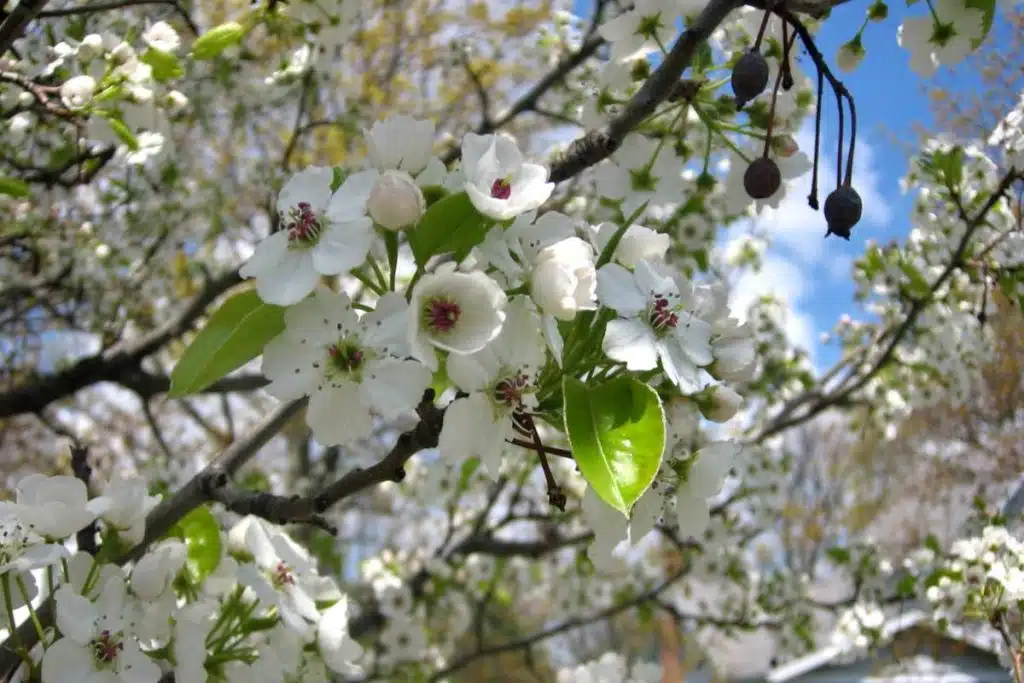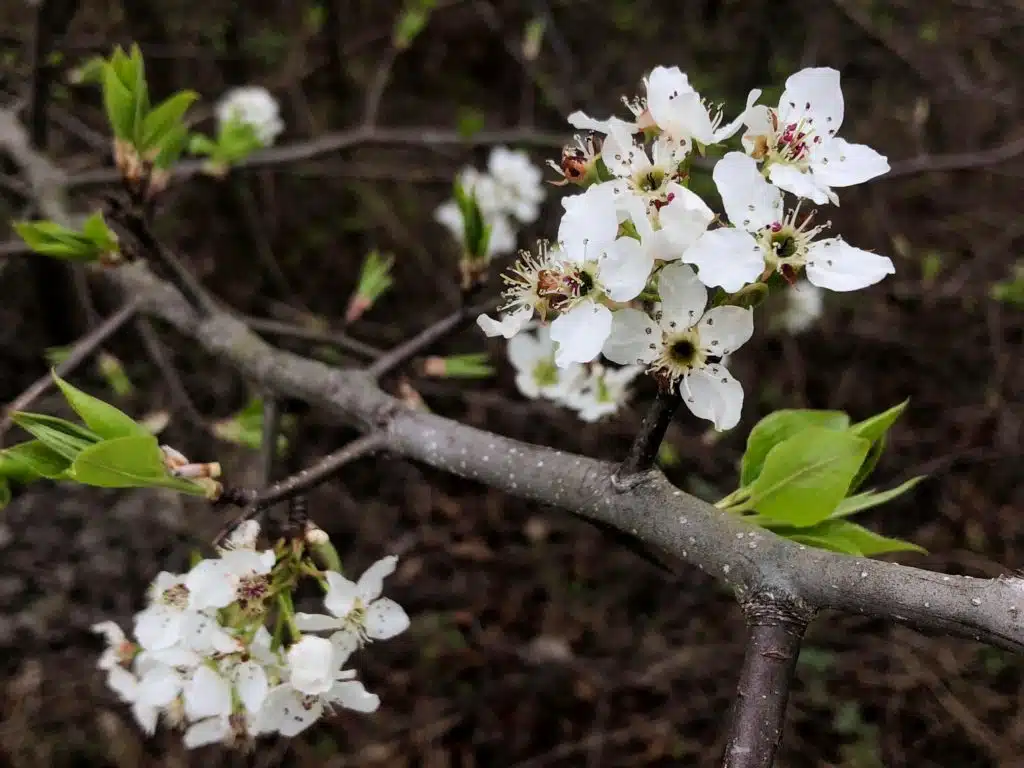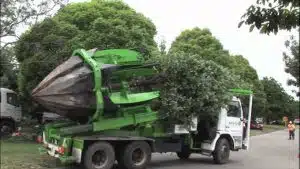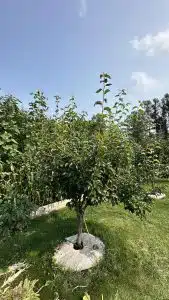Pruning pear trees is both an art and a science, involving meticulous attention to detail and a thorough understanding of tree biology. Arborists in League City must master the skill of pruning to keep their trees healthy and produce as much fruit as possible. This detailed tutorial delves into the complexities of pruning pear trees, providing professional insights, practical advice, and step-by-step instructions to help arborists improve their skills.
Understanding Pear Tree Growth Patterns
Seasonal growth cycles
Understanding pear trees’ seasonal development cycles is critical for successful

trimming. Arborists must time-trim operations to coincide with the tree’s natural rhythms, from hibernation in winter to robust growth in spring and summer.
Branch architecture
Pear trees have distinctive branch patterns, which include scaffold branches, water sprouts, and suckers. Knowing how to identify and maintain these structures is critical to structuring the tree for maximum health and productivity.
Fruit Bud Formation
Pruning is essential for promoting fruit bud growth and guaranteeing consistent harvests. Arborists must grasp the relationship between pruning practices and fruiting habits to ensure numerous harvests.
Response to Pruning
Pear trees react differently to different pruning cuts, with some stimulating vigorous growth and others promoting fruit yield. Understanding these responses allows arborists to modify their pruning strategy to obtain the desired results.
Tools required to prune a pear tree
Pruning shears are perfect for making accurate cuts on tiny branches.
Loppers: Use loppers to cut larger branches that pruning shears cannot handle.
Pruning saw: A pruning saw is necessary for larger branches or limbs.
Safety Gear: Wear gloves, safety goggles, and a helmet to protect yourself.
How to Prune a Flowering Pear Tree?
Pruning a flowering pear tree demands careful attention to detail to guarantee the tree’s health and attractiveness. Follow these steps to prune a blossoming pear tree:
Assess the Tree: Start by looking at the tree’s overall structure and health. Look for dead, damaged, or diseased branches that should be removed. Take note of any branches that cross or grow inward towards the tree’s centre.
Identify pruning goals: Determine your trimming goals before you begin. Are you trimming to remove dead or diseased branches, improve the tree’s shape, or increase fruit production? Having a specific aim in mind will help you make trimming selections.
Prune Dead or Diseased Branches: Begin by removing any dead, damaged, or infected branches. These branches can harbor pests and diseases, so they should be cut back to healthy wood. Make clean cuts slightly outside the branch collar, where it connects to the trunk or main branch.
Thin Out Crowded Branches: Next, remove any branches that are crossing or rubbing together. Aim to make an open canopy that allows for optimal air circulation and light penetration. Remove branches that are growing inward towards the tree’s centre to promote airflow and prevent illness.
Shape the tree: Once you’ve removed any dead or crowded branches, step back and assess the tree’s overall shape. Prune back any branches that are growing too long or out of shape to maintain a balanced and aesthetically pleasing appearance.
Promote Fruit Production: When pruning a fruit-bearing pear tree, remove any branches that are overloaded or growing vertically. Thin the canopy to allow sunlight to reach the interior branches, resulting in improved fruit production and ripening.
Finish with Final Touches: Once you’ve finished pruning, take a final look at the tree and make any more cuts as needed. Remove any little sprouts or water sprouts that may have developed during the pruning procedure.
Clean Up and Dispose of Debris: When you’re finished pruning, remove any debris and properly dispose of it. This will help keep illness and pests at bay while also keeping your landscape neat.
When is the best time to prune a pear tree?
Pruning a pear tree is best done during its dormant season, which runs from late winter to early spring before new growth begins. Pruning during this time allows the tree to repair more quickly and reduces stress on it. Furthermore, pruning during dormancy improves the visibility of the tree’s structure and any dead or diseased branches that should be removed. Pruning in late winter or early spring promotes healthy development, improves tree structure, and encourages prolific fruit production over the ensuing growing season.
Related Posts:
DIY vs Professional pruning of pear tree
DIY pruning is a cost-effective option for homeowners who have the time, tools, and knowledge. It allows a person to maintain their trees according to their preferences and schedule. DIY pruning can promote a sense of satisfaction and connection with the garden, fostering a deeper appreciation for the tree’s growth and health. However, inexperienced pruning can lead to improper cuts, which may damage the tree and compromise its growth.
On the other hand, professional pruning offers expertise and precision. Arborists have specialized skills and knowledge in tree care, and they can assess tree health properly. They use professional-grade tools and techniques to ensure optimal results. It also reduces the risk of accident or injury, as they have climbing ladders and power tools.
FAQS
How much should I prune my blossoming pear tree?
The quantity of trimming required depends on the tree’s size, health, and growth tendencies. It’s wise to start slowly and modify as necessary.
Can I prune my pear tree myself, or should I hire an arborist?
Homeowners can complete minor pruning activities, but sophisticated or large-scale pruning may necessitate the services of a professional arborist to ensure appropriate technique and tree health.
Will trimming my pear tree affect fruit production?
Pruning can boost fruit output by encouraging new growth and boosting air circulation in the canopy. However, poor pruning practices may hurt fruit production.
How often should I prune my pear tree?
Annual pruning is beneficial to pear trees because it helps preserve their shape, removes dead or diseased wood, and promotes healthy development. However, the frequency and extent of pruning may vary according to the age and condition of the tree.
What should I do if my pear tree’s branches or limbs have become overgrown?
If your pear tree has overgrown branches or limbs, you should hire a professional arborist to prune it safely and effectively while avoiding harm.
Conclusion
Pruning pear trees is both an art and a science that necessitates expertise, knowledge, and a thorough understanding of tree biology. For arborists in League City, understanding the skill of pruning is critical to keeping healthy, beautiful trees and ensuring plentiful harvests year after year. By following the expert advice provided in this thorough guide, League City arborists may trim pear trees with confidence, knowing they are improving the beauty, health, and longevity of these valued landscape species.




